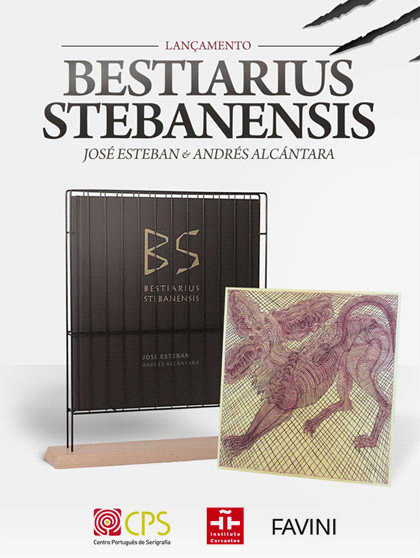
Presentation of the book "Bestiarius Stebanensis"
José Esteban & André Alcántara
On May 9, at 6:30 pm, a special edition of the book BESTIARIUS STEBANENSIS by José Esteban and Andrés Alcántara is presented at the Instituto Cervantes in Lisbon (Rua de Santa Marta 43F).
The presentation will count with Tomás Paredes, President of the Spanish Association of Art Critics and the authors.
Simultaneously and at the same Institute, two exhibitions of Andrés Alcántara will be inaugurated. “Drawings of Bestiarius Stebanensis” and “Cervantes and Quixote”.
About BESTIARIUS STEBANENSIS
All the bestiaries that have come to us are derived from the Greek Physiologus, 3rd-5th centuries, written in Alexandria, by an unknown author. Bestiaries respond to man's imaginative faculty, to his ability to enrich reality, describing natural and fantastic creatures, assigning to them symbolic meanings.
Edited by Centro Português de Serigrafia, the special edition of BESTIARIUS STEBANENSIS brings together more than twenty animal creatures, in José Esteban's stimulating and genuine texts combined with the emotive and visionary drawings of Andrés Alcántara. From the universal bestiary, the sea serpent, the dragon or the phoenix; to that of the ancient world, the swan of Leda, the bull of Europe or the horse of Attila; to the medieval bestiary, the beast of the Apocalypse, the crow of São Paulo or Cérbero dog to the modern world, from the donkey of Sancho Panza to the bull Grenadine.
As the author of the prologue, Tomás Paredes (President of the Spanish Association of Art Critics) says, “Bestiarius Stebanensis is stimulating, genuine, arbitrary, delusional, subjective, exact, unsettling. Through its various records, the oldest Greek and adjacent mythologies, the Holy Scriptures, echoes of India and China, pass through. Medieval remains, Patristics, Romanticism, and then Borges, Eliade, Freud, Bachelard, Roland Barthes and the world of bulls. It comprises an overlapping of eras and civilizations, from ancient Egypt to Ignacio Sánchez Mejías.”
The book was composed by João Prates associating different types of fonts to the different eras. The translation was done by Jorge Melícia. With a screenprinted cover and manual binding, each book is inserted in a metallic support, suggesting the idea of a cage, based on a wooden base. This same support is numbered and signed by the two authors.
They were only made 84 copies numbered and signed by the intervenients and each book includes a burin engraving by Andrés Alcántara, also numbered and signed.
The exhibitions are open until the 5th of July with free admission.
Instituto Cervantes of Lisbon
R. de Santa Marta 43F, 1150-140 Lisboa
Tel. +351 21 310 5020
Editor: Centro Português de Serigrafia
Partner: Instituto Cervantes of Lisbon / Favini